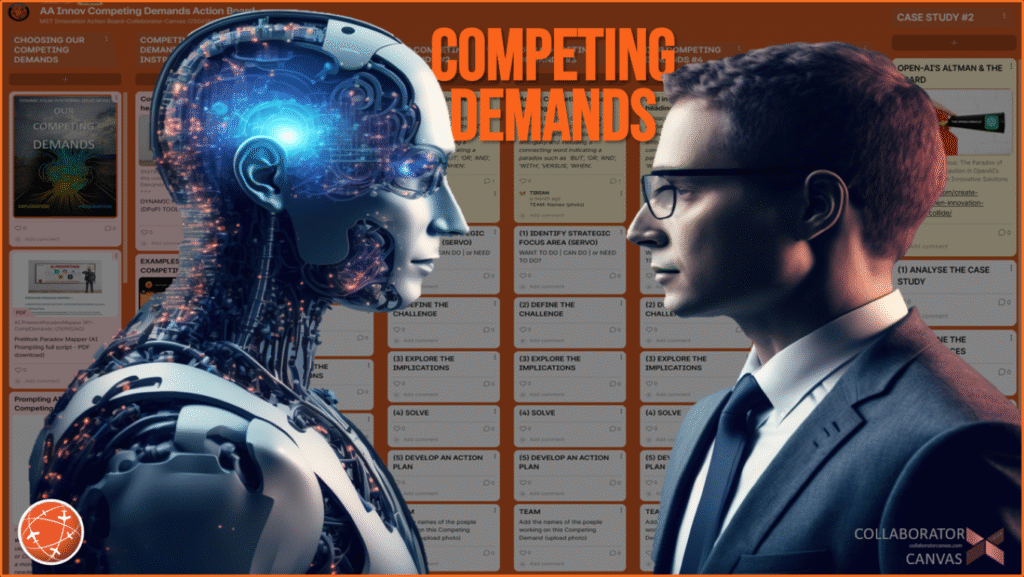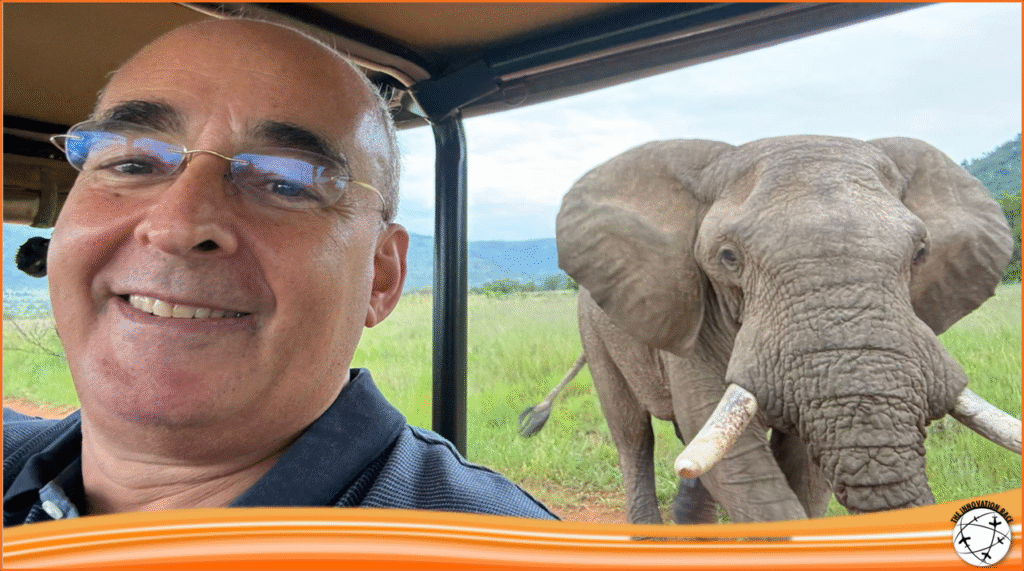Move Fast, But Don’t Trip: Leading Through the Paradoxes of the AI Race
Is it possible for leaders to embrace the potential of AI while also protecting what matters most? This AI paradox isn’t just a tech conversation — more importantly it’s a leadership one. Balancing the ‘Explore’ and ‘Preserve’ mindsets is the key to the difference between chasing hype and creating lasting value.
Leadership teams are wrestling with the push–pull of rapid AI adoption in boardrooms worldwide. Yet far from the tech world, in the game parks of South Africa, we discovered an interesting illustration of how we can approach this paradox. We realised our very different reactions to being charged by a bull elephant reflected how differently we perceive this dilemma. It made us consider:
– Do you charge ahead? | Do you hold your ground? | Or do you find a way to do both?
How leadership teams wrestle with the paradox of embracing AI’s potential while preserving human judgment, culture, and control.
The story: Just a few months ago, we found ourselves deep in the savannahs of Africa. It was exhilarating—surrounded by the raw beauty and unpredictability of the wild. That is, until we were chased by a bull elephant. Not a distant sighting, but a full-force, ears-flared, angry charge.
In that moment, instinct took over. Some urged the driver to hit the gas. And some were secretly thrilled by the adrenaline of facing something so powerful and untamedsecretly, whilst others were scrambling to get a selfie.
Later, back at camp, we laughed—and reflected. That moment captured something profound: the way people respond to digital disruption. Some engage directly, navigating risks and rewards in real time. Others prefer the safety of a zoo, where the wild is behind glass. And some are content watching from the couch, remote in hand—analyzing from a safe distance.
But the wild is coming. Whether we’re ready or not. Even Sam Altman says “no-one knows what will happen next.” So if this is the case, then the most important skill leaders will need going forward is how to manage the technology, and the transformation it will bring.
Beyond the media’s glittering predictions lies the urgent need for a grounded, practical approach—giving leaders the tools to lead decisively through turbulence and complexity.
Flight: urged the driver to hit the gas ….
Secretly thrilled by the adrenaline of facing something so powerful ….
… scrambling to get a selfie …
AI Isn’t a Magic Bullet—It’s a Muscle-Building Regimen
Why Sustainable Innovation Requires Both Explorers and Preservers.
In the race to boost productivity, artificial intelligence (AI) is being hailed as a miracle cure. Politicians and CEOs alike are prescribing it like penicillin—an all-purpose remedy for economic stagnation. But as The Conversation has pointed out, AI is no panacea. It’s more like physiotherapy after major surgery: it only works if you commit to the process, follow the program, and engage the right people.
This metaphor is especially apt when viewed through the lens of Dr Gaia Grant’s research on innovation leadership. In The Innovation Race, Grant introduces the concept of Explorers and Preservers—two distinct innovation mindsets that must be balanced for sustainable transformation.
Explorers are the bold pioneers who push boundaries and embrace risk. Preservers, on the other hand, are the stabilizers who ensure continuity, governance, and trust.
Move Fast, But Don’t Trip: Leading Through the Paradoxes of the AI Race
As AI reshapes industries and redefines the future of work, leaders face a new paradox: how to harness the power of intelligent technology without losing the uniquely human capabilities that drive innovation. Leaders will need to learn how to lead in an era where creativity, complexity, and AI must coexist.
When it comes to AI adoption, most organisations are driven in this area by ‘Explorers’. They move fast, break things, and often implement AI without fully engaging the workforce.
But this approach is proving costly. According to current research, 80% of AI projects fail—not because the technology is flawed, but because of poor staff engagement, lack of trust in something ‘new’, inadequate training and weak governance. Only one in four executives reported meaningful returns on their AI investments.
This is where the diagnostic tools, such as the Innovator’s Profile (iCLi), become essential. They help leaders identify their own bias—whether they lean toward exploration or preservation—and build ambidextrous teams that can navigate both disruption and stability.
Without this balance, organisations risk falling into what economists call “so-so automation”: replacing workers with AI without achieving real productivity gains. In fact, 55% of UK executives who replaced staff with AI later regretted it.

Why Most CEOs and Companies Tend Toward Preservation
In the book The Explorer’s Gene” by Alex Hutchinson, he explores why some individuals—and by extension, some leaders—are wired to seek novelty, challenge, and uncertainty, while others lean toward stability and exploitation /preservation. He believes that most organizations—and their leaders—default to exploitation /preservation for several reasons:
- Predictability and ROI: Exploiting known products or markets offers measurable returns and lower risk, which shareholders and boards typically favor.
- Cognitive Bias: The brain’s predictive processing system prefers familiarity and dislikes surprises. This makes leaders more likely to reinforce existing strategies than venture into the unknown.
- Organizational Inertia: Large companies often develop rigid structures that resist change. Exploration requires agility, which is harder to maintain at scale.
- Short-Term Pressures: Quarterly earnings reports and investor expectations push CEOs to deliver consistent results, discouraging long-term bets.
- Risk Aversion: Exploration involves failure. Many corporate cultures penalize mistakes, making leaders hesitant to pursue bold ideas.
A Case Study in Exploratory Leadership:
Jensen Huang, co-founder and CEO of NVIDIA, is a rare example of a leader who embodies the explorer’s gene:
- Big Bold Bets: Huang famously reinvested profits into speculative research—like GPUs for AI—long before the market validated them.
- Flat Structure: He runs NVIDIA with 40+ direct reports and no formal planning cycles, fostering agility and transparency.
- Stochastic Sampling: Instead of status reports, he reads daily emails from employees listing their “top five things,” keeping him close to the company’s pulse.
- Radical Transparency: Meetings are open to all, and strategic decisions are discussed publicly, encouraging idea flow across ranks.
- Long-Term Vision: Huang’s focus on foundational technologies like generative and physical AI has positioned NVIDIA as a trillion-dollar company.

Here are some areas to consider when dealing with AI:
- Shift from imposing to co-creating: How to avoid the AI pitfalls
Companies must shift from imposing AI to co-creating it with their people. This means involving ‘Preservers’ early in the process—those who may be skeptical but are essential for long-term adoption. For a more preserving mindset to adopt new innovations and ensure it is implemented in a sustainable way, such as AI, this requires trust, transparency, and a shared sense of purpose and a more incremental rollout approach. - From FOMO to Focus: Finding Balance in the AI Implementation Paradox
This creates a classic competing demands paradox: Organisations are caught between keeping up with the AI trends and sustainable implementation. Whether this be pure FOMO, or a realistic ‘adapt or die’ predicament. Move too fast, and risk destabilising your systems. Move too slow, and risk being left behind in the AI Innovation Race. - Trust Isn’t Optional: Why the Most Advanced AI Still Needs Human Buy-In
The data backs this up: organisations that meaningfully engage employees in transformation efforts are nine times more likely to succeed. AI works best not when it replaces human capability, but when it amplifies it. Workers bring contextual knowledge, emotional intelligence, and practical insight—qualities no algorithm can replicate.
If AI is the physiotherapy, then Explorers and Preservers are the muscles that must work in tandem. One drives the stretch; the other ensures the strength. And only together can they build the resilience needed to thrive in the innovation race.

LEADING AI: Reflection questions to consider
Questions to consider: on how to lead AI with clarity, navigating the paradoxes of speed, ethics, and innovation to build a smart, resilient culture in the age of disruption.
- When has “moving fast and breaking things” helped—or hindered—your team’s adoption of new technology?
(What did you learn about balancing innovation with trust?) - Do you lean more towards the Explorer or Preserver when it comes to driving change in your organisation?
(How does that impact how you engage with AI or digital transformation?) - What’s the most effective way you’ve seen employees meaningfully included in innovation rollouts?
(Is co-creation part of your team’s change DNA?) - Have you experienced “so-so automation”—where a shiny new tool over-promised and under-delivered?
(What would you do differently now?) - Is Your AI Strategy a Power Move or Panic Response?
(How can co-creation with people—not just code—become the true competitive edge in AI implementation?) - How can we best navigate the paradoxes of speed, ethics, and innovation to build a smart, resilient culture in the age of disruption?

LEADING AI: Keynotes, workshops and collaterals
AI is accelerating change at breakneck speed—amplifying both opportunity and complexity. To lead effectively, leaders must navigate the competing demands it creates and guide teams through the tensions it surfaces. Drawing on global consulting experience and cutting-edge research, the Grants reveal how the most future-ready leaders embrace paradox, not as a problem to solve, but as a dynamic tension to navigate. The topic of this article is available as a keynote, workshop and biz facilitation. Below are several ways to focus on this topic and assist.
- Embracing the AI Paradox to Win the Innovation Race: A Futuristic Keynote that equips leaders to move beyond trendspotting, with a focus on future-proofing with substance: not predicting the unknown, but empowering leaders to shape it.
- The Innovative Change Ready Leader: Developing Ambidextrous Leaders with the Future-Ready Mindset – for dealing with rapid change and innovation, including AI-transformation.
- The Innovation Team: Fostering Aligned Teams – how to embrace innovation and change to lead aligned teams.
- The Agile Innovation Organisation: Mapping innovation culture for strategic organizational alignment
- Purpose-driven Innovation Leadership: How to make confident decisions in a complex AI-driven world – including the Purpose-Driven Innovation Radar tool (PDIR) for building decision-making
- The AI Utilization Dial: Maximizing Creativity Without Losing Control
- Learning to Lead in an AI-Shaped World: How and when to use AI, especially in the design of a learning experience (workshop / keynote / gamified simulation)
- INNOVATIVE Competing Demands Collaborator Canvas; Self-lead your own session to explore competing demands.






